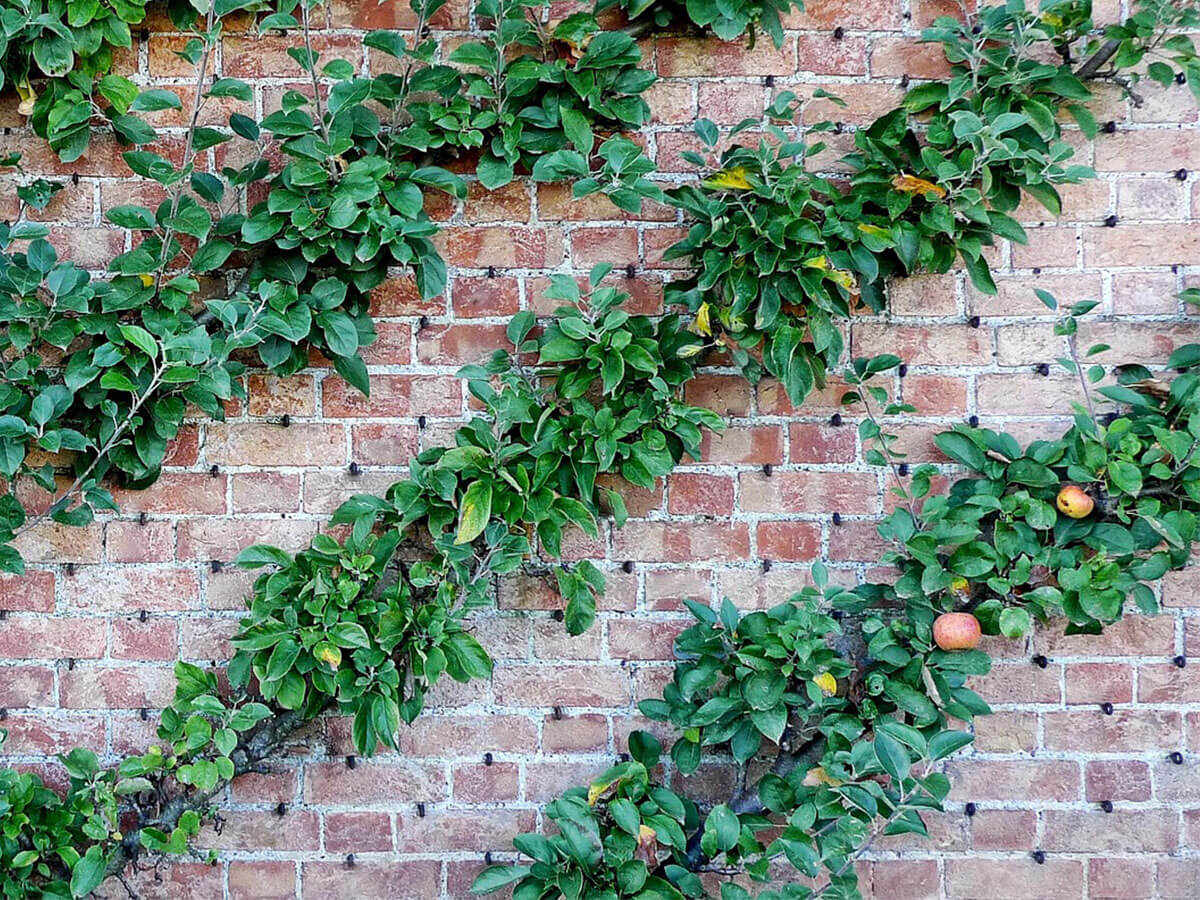How to Grow Apple Trees in a Small Garden or Balcony
August, 2023 |Interested in growing your own small apple tree in your mini garden space? Apple trees are a familiar garden favorite, but we may often associate apple trees with acre-sized orchards or large gardens.
However, there are now urban-friendly apple tree options that allow us to easily grow apple trees in small gardens too. Ideal for urban spaces, city balconies, or small porches.
Can you keep apple trees small?
Definitely! You can grow apple trees in the smallest of gardens, from narrow balconies to porches. It all depends on the apple tree rootstock you choose and/or how you care for and maintain your apple tree.
If you’re buying a new apple tree, look for the following…
Apple trees that have been grown on dwarf or semi-dwarfing rootstock, as these will have a maximum mature height.
Or…
Apple trees that have been specially trained into a compact shape, like columnar apple trees or espaliers.
If you already have an apple tree…
If you’ve already planted a standard variety or have inherited an apple tree, it is possible to keep your apple tree small with attentive pruning.

A Guide to growing apple trees in a small garden
Below you’ll find helpful info on choosing the right apple tree for your space, caring for it, and maintaining its growth.
- Choosing a rootstock: Dwarf apple trees (and semi-dwarf)
- Trained apple trees for small spaces: Espalier, cordon, column, and step-over
- Positioning: How much space does a small apple tree need?
- Things to consider before choosing an apple variety: pollination, hardiness, etc.
Choosing a rootstock: Dwarf and semi-dwarf apple trees
For a more natural ‘tree’ shape, dwarf apple trees are ideal. These apple trees will have been grown on semi-dwarf or dwarf rootstock which helps to naturally restrict their size. This means that they won’t grow to overwhelm your small garden.
To make sure your apple tree stays small, you’ll need to check which apple tree rootstock a small apple tree has been grown on before buying.
Different types of fruit trees have different rootstocks that can help to limit the tree size. Look for these dwarf rootstocks for apple trees…
- M27 extreme dwarf trees (usually about 6 feet)
- M9 dwarf trees (usually between 6-7 feet)
- M26 semi-dwarf trees (usually reach between 10-13 feet)
Just be aware that the label won’t mention the rootstock in some nurseries, but it will say things like ‘patio apple tree’ or ‘dwarf apple tree’.
Dwarf or semi-dwarf apple trees?
The difference between semi-dwarfing and dwarf apple trees is their size and manageability.
Dwarf and extreme dwarf apple trees will reach maturity at about half the size of a standard apple tree — usually about 6 feet in height. They’re perfect for small gardens with very limited space, like a small patio.
Semi-dwarfing apple trees will reach maturity at about three-quarters the size of a standard apple tree. They’re great for small to medium-sized gardens where you can dedicate more space.
Trained apple trees
If you have a really small or narrow space, like a balcony, then a trained apple tree is one of the best space-saving apple trees. You can buy cordon, column, step-over, or espalier apple trees which have been specially trained into a compact or slim shape.
Columnar apple trees have the smallest ‘footprint’ as they have a single main stem that stands tall and upright with extremely short lateral shoots where apples will grow close to the stem. These apple trees are usually about 1-2 feet across, making them perfect plants for narrow spaces. They may also be called ‘cordon’ trees.
Espalier apple trees have out-stretched, horizontal branches and a narrow shape where the branches are trained to grow against a wall or fence. You may also find ‘Fanned apple trees’ which have a more fan-like shape, but these are less common and often more difficult to maintain. Another option is a step-over apple tree, which is a bit like an espalier, however, it has only two, low horizontal branches that you could ‘step over’!
These trained apple trees can be planted close to your house or a wall or fence. For example, you might keep a columnar apple tree in a sunny spot in the corner of your balcony. Or you might buy and plant an espalier apple tree against your back fence where it catches the sun.

How much space does a small apple tree need?
Depending on the apple tree rootstock (e.g. whether it’s grown on a dwarf M9 rootstock) and/or its trained shape, you can grow a small apple tree in as little as 2 feet of space. A column apple tree is the best apple tree for very small spaces.
Planting an apple tree near a house or obstruction
If you’re letting your dwarf apple tree grow naturally, it’s generally best not to plant it next to a house, wall, or fence. As its branches grow outwards, you’ll have difficulty pruning the side of the tree that is growing towards the house or obstruction.
However, if you’re growing a trained apple tree, like an espalier or cordon apple tree, you can plant it close to a wall. Placing it near a wall can actually act as a form of support as you can attach supports to a wall to hold branches in place.

Can you plant dwarf apple trees in the ground?
As well as being kept in containers, dwarf apple trees can also be planted in the ground. However, keeping them in a container can help to restrict the roots and the size of the apple tree. Plus, if you move house or apartments, you can bring your apple tree with you!
Things to consider before choosing an apple variety
So you know which rootstock or trained method you are interested in. Now it’s time to find an apple variety.
There are over 7500 apple varieties, each one uniquely grown for certain tastes, colors, looks, textures, hardiness, and recipes (e.g. cider making or dessert apples!). Some apple varieties are popular favorites, like Gala, Granny Smith, or Red Delicious. But you can also find some unique varieties too.
If you’re looking for some unusual fruits to grow, try a red-fleshed apple variety from the Red Love cultivar.
So, before you head out to buy an apple tree variety at a local nursery or online, there are a few things you need to consider before choosing a variety…
- Pollination: Before picking an apple variety, check how it needs to be pollinated. For some varieties, you need 1-2 other trees for successful pollination.
- Hardiness zone: Some apple varieties are more drought or cold-tolerant than others, make sure you pick one that matches your climate.
- Disease resistance: Check each variety to see which diseases it may be susceptible to. Some apple varieties can be more susceptible to certain diseases than others. For example, the popular Cox’s Orange Pippin isn’t recommended for cold and wet areas where it may be affected by Apple Scab.
- Sunlight: Apple trees need at least 6-8 hours of sunlight a day to ripen, so try and place your apple tree in the sunniest spot of your small garden.
And also, make sure it’s a variety that you actually like to eat! It’s no use having a ‘Bramley’s Seedling’ apple tree if you’re not a fan of apple pie 🙂

Ongoing care and pruning
For info on looking after your apple tree check out our guide to growing fruit trees in containers. It includes helpful tips on choosing the right container size, watering, and winter care.
Pruning is another important task when you’re growing your own fruit trees. Attentive pruning will help your tree produce more fruit and also keep it small! Although important, it doesn’t have to be overwhelming.





